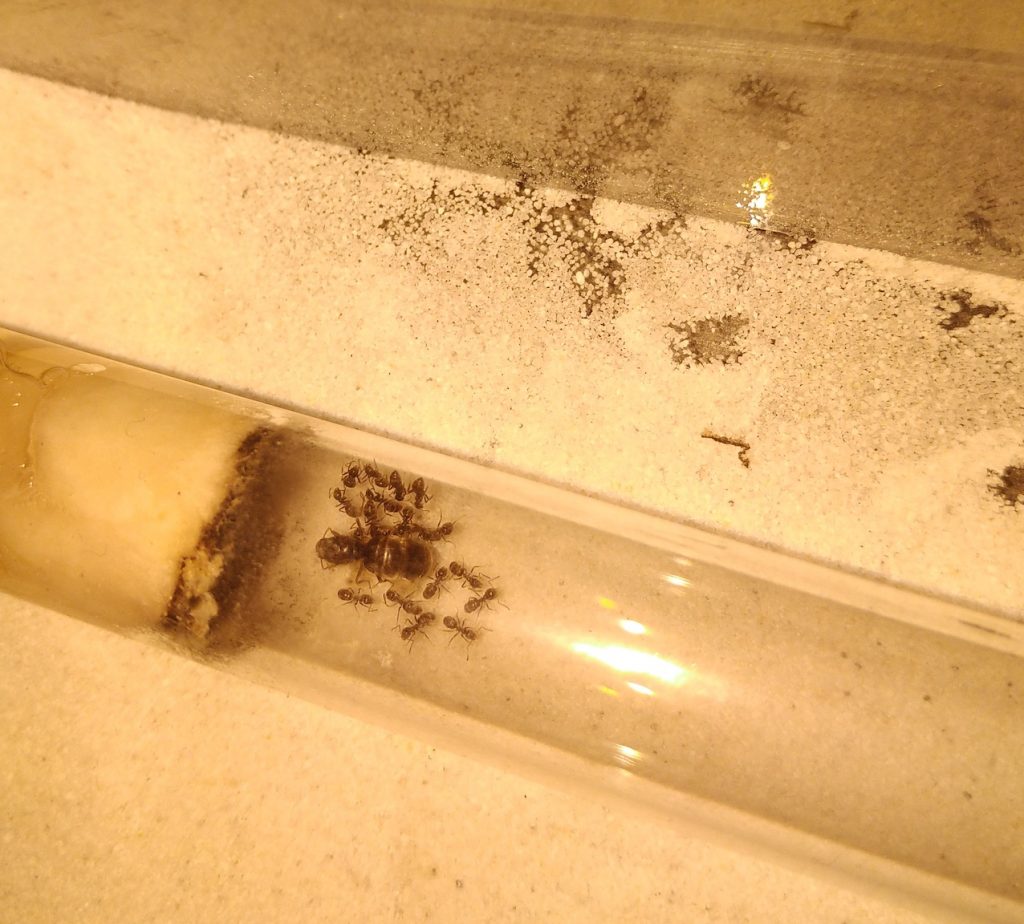Happy New Year 2020 to all my readers/visitors/supporters. Thank you so much for your continued support on my website.
My ants have celebrated the New Year – by staying in their hibernation beds, except, that is, for the Lasius umbratus. They have remained fairly active so far this winter, though in greatly decreased numbers. The Lasius niger and Myrmica rubra have rarely been out of their nests over the past month or so, though I did see one L. niger worker put foraging yesterday, and 4 Myrmica rubra workers eating some protein jelly.
Ant Room temperature: 8*C / Outside temperature: 6*C
Lasius niger
The queen and her 18 workers look healthy enough, and they still have their wintered brood, consisting of larvae that have paused their development during these colder months. They remain in their glass test tube. Though I do wish they would discover and move into the nesting box I have given them, there is an advantage to them staying in their test tube: I can clearly see in and monitor the progress of the young colony. Being able to see easily into a colony when keeping ants in winter is a bonus.
Lasius umbratus
Slow progress still continues with the new nest, though no sign of them moving in yet. Their old (current) nesting box is looking really tatty inside but they appear content to remain there at this present time. There are probably only about 100 workers present in this nest now. However, there is still a fair number of larvae within the brood chambers. I cannot see the queen. Perhaps she is hidden away. Very little movement occurring within the nest when I peeked in a moment ago.
Myrmica rubra
Very little in the way of activity in the rubra nest today, even when I removed the covering to look inside. Most of the ants are in the lower chamber where they are huddled together. Keeping ants in winter can be … quiet!
My plans for 2020 are to NOT get any new ant colonies (yeah, let’s see how long that idea lasts!). I will probably buy another ant farm set up or two from AntsUK. I intend to conduct an over-feeding challenge on my young Lasius niger and Myrmica rubra colonies, to see if I can get their numbers boosted a lot by the end of the year. I want to see how prolific at egg laying the respective queens can be.
Again, thank you to everybody who supports my website, whether you’re an occasional visitor, or a regular one, and whether you contribute to these blog entries or prefer just to read and remain in the background. I really do appreciate every one of you.
Finally, just in case you do happen to be reading this, Dermy: Happy New Year 2020. I hope 2020 will be the best year of your life so far.

Happy new year Myrm, glad to see u back online , well done for the informative page ! Love reading them
Hey JD
Thank you so much for your kind comments, and for your continued support. You are a good friend and I appreciate your friendship vary much.
Hello. I am a 14 years old boy from Iceland. I like your website very much. What ant specie are there in Iceland. Sorry for my bad English, school is teaching me it.
Hi Aron
Thank you so much for your comment.
Bad news I’m afraid; Iceland has no native species of ant – it’s too cold for them there. I’m guessing you probably have not seen any there? I’d be most interested in hearing about any you have found there.
There are Europe based companies that sell ant colonies, but I am not sure what the rules are on sending ants to Iceland. You will need to contact them and ask if they can send them to you. I have a feeling they may so no. Sorry 🙁
That is really sad to know. I have never seen any ants here. My science teacher said there were no ants here but I wanted to ask you to see if he is right. I will keep reading your site and articles. Thank you.